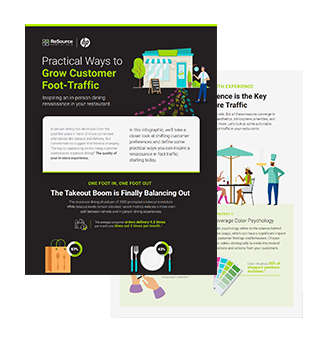The restaurant industry has seen significant changes over the years— largely spurred by technological advancements, changing consumer preferences, and a rapidly evolving market landscape. As a point of sale (POS) provider for restaurants, ReSource has a unique perspective on how these changes have affected the industry. In this blog, we will dive into the evolution of the restaurant industry and the ways it has impacted the POS market.
Early Days
Restaurants date back to ancient civilizations, but it wasn’t until the 18th century that the concept of a restaurant, as we know it today, emerged. The first modern restaurant, the Grand Taverne de Londres, opened in Paris in 1782. Restaurants at that time were relatively simple establishments, serving traditional dishes in a formal setting.
The 20th Century
The 20th century saw the rise of fast-food chains and franchising. In 1940, Richard and Maurice McDonald opened the first McDonald’s restaurant in California, marking the beginning of the fast-food revolution. As chains like McDonald’s, Burger King, and Wendy’s became more popular, the fast-food industry exploded.
The 1980s and 1990s saw the introduction of computerized POS systems. These systems made it easier to process orders, manage inventory, and track sales. Initially expensive and inaccessible to many establishments, the benefits they provided quickly made them a must-have in restaurants world-wide.
The Rise of Technology
The 21st century brought about significant technological advancements in the restaurant industry. With the rise of smartphones and tablets, mobile POS systems became more accessible and affordable. In recent years, cloud-based POS systems have also become more popular, allowing restaurants to access their data from anywhere with an internet connection.
The use of social media has also transformed the way restaurants can interact with their customers. With platforms like Facebook, Instagram, and Twitter, restaurants are able to connect with their customers on a more personal level while, promoting their business through targeted, yet organic advertising.
The COVID-19 Pandemic
The COVID-19 pandemic had a significant impact on the restaurant industry. Many restaurants were forced to close their doors temporarily, leading to widespread unemployment and economic hardship. Those that remained open had to adapt to new safety guidelines, with restrictions such as social distancing and reduced capacity.
The pandemic also accelerated the adoption of new technologies, such as contactless payments and online ordering. Restaurants that were quick to adapt were able to survive and even thrive, through utilizing these digital tools during the pandemic.
The Future of the Restaurant Industry
The restaurant industry is constantly evolving, and the future looks bright. With the widespread adoption of technology, restaurants can streamline their operations and provide a better customer experience. Online ordering and delivery services will continue to grow, allowing restaurants to expand their reach and increase revenue. With new innovations and advancements constantly emerging, it can be hard for restaurant owners and operators to keep up. Here’s a look at some of the latest trends in restaurant technology and how they can benefit businesses.
- Mobile Ordering and Payment Mobile ordering and payment is becoming increasingly popular, as more and more customers are looking for a quick and convenient way to order and pay for their food. By implementing mobile ordering and payment systems, restaurants can streamline the ordering process, reduce wait times, and improve the overall customer experience.
- Cloud-Based Point of Sale (POS) Systems Cloud-based POS systems are becoming the go-to solution for many restaurants, as they offer several advantages over traditional on-premise systems. These systems are more affordable, easier to maintain and update, and can be accessed from anywhere with an internet connection. Additionally, cloud-based POS systems provide robust reporting and analytics, enabling restaurant owners to gain valuable insights into their operations.
- Online Ordering and Delivery Online ordering and delivery have been a major trend in the restaurant industry for several years now, and it’s only getting more popular. By offering online ordering and delivery, restaurants can expand their customer base and increase revenue, as customers can order from anywhere at any time. This trend became especially important during the COVID-19 pandemic, as many restaurants had to rely on online ordering and delivery to survive.
- Digital Menu Boards Digital menu boards are another emerging trend in restaurant technology. These boards allow restaurants to easily update their menus, showcase specials and promotions, and provide a more engaging and interactive dining experience. Additionally, digital menu boards can help restaurants reduce printing costs and waste, as well as increase upselling and cross-selling opportunities.
- Artificial Intelligence (AI) and Machine Learning AI and machine learning are rapidly transforming the restaurant industry. These technologies can be used to optimize menus, predict customer preferences, and automate various tasks, such as inventory management and food preparation. By leveraging AI and machine learning, restaurants can reduce costs, improve efficiency, and provide a more personalized experience for their customers.
In conclusion, restaurant technology is constantly evolving, and it’s essential for businesses to stay up-to-date on the latest trends and innovations. By embracing these technologies, restaurants can improve the customer experience, increase efficiency, and ultimately drive growth and success. At ReSource Point of Sale, we’re committed to providing cutting-edge restaurant technology solutions to help businesses thrive. Contact us today.

